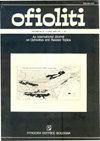EARLY CRETACEOUS ACCRETIONARY COMPLEX OF THE VALAISAN OCEAN, WESTERN ALPS?
IF 1.3
4区 地球科学
Q2 GEOLOGY
引用次数: 2
Abstract
Based on detailed field investigations and structural mapping in the Petit-Saint Bernard Pass area (French-Italian border), the Versoyen Complex is newly defined as an imbrication of four structural units. The first one is composed of the remnant of the Valaisan ocean floor (“basalt” and “black schist” formation) and the other three units -grouped under the name of “schistes a blocs”- contain blocks with different origin: oceanic, continental or a mix of both, embedded in a matrix of grey micaschists. Kinematic analysis highlights the compressional style of this complex with a well-developed stack of tectonic slivers. Rocks in the tectonic melange include Paleozoic green gneiss and grey-green micaschists blocks, together with Upper Paleozoic granitoid and layered gabbro, which display a typical orogenic calc-alkaline signature, comparable to that of coeval plutonic rocks of the Brianconnais continental basement attributed to a late Variscan back-arc environment. A new isotopic dating on a calc-alkaline layered gabbro block gave a U/Pb zircon age of 310 ± 4 Ma, in the range of other dated plutonic rocks such as the Punta Rossa and Aiguille du Clapet megablocks. These Paleozoic continental basement rocks of the Versoyen Complex were initially rift allochthons, but are now outcropping as a tectonic melange, with imbricated blocks and slivers within an Early Cretaceous grey micaschists matrix. Radiolarians sampled by Beltrando et al. (2012) within the grey micaschists have been attributed to the Late Jurassic - Early Cretaceous. Additional stratigraphic and geodynamic constraints allow us to restrict the deposition of the Versoyen sediments from the Aptian to Cenomanian times. The Versoyen Complex is unconformably overlain by the Valaisan Trilogy (Aroley-Marmontains-Saint Christophe) of Cretaceous age. The Turonian Aroley strata deposited on the Versoyen “schistes a blocs” units and the absence of any Aroley limestones within the underlying tectonic melange testify a clear stratigraphic unconformity, mapped regionally, between the Versoyen Complex and Valaisan Trilogy. Both are affected by a high-pressure metamorphism related to the Alpine collision around 40 Ma and trace of former metamorphism are nowhere observed suggesting that the former melange did not result in a significant tectonic thickening. We interpret the Versoyen Complex, as a pre-Alpine Cretaceous subduction-related accretionary prism, formed during the closure of the Valaisan Ocean. Valaisan rifting initiated during the Late Jurassic, as a consequence of an eastwards propagation of the North-Atlantic rifting towards the Alpine region. This propagation followed pre-existing Variscan structures along the Zone Houillere, explaining the present marked differences between Variscan basements on each side of the Valaisan suture (External Crystalline Massifs and Brianconnais basement). Due to the southward subduction of the Valaisan Ocean, this passive margin was later on deformed through compressional shearing tectonics, developing a “schistes a blocs” fabric and imbricating the former rift allochthons. During the Tertiary Alpine collision, Versoyen and Valaisan Trilogy units were deeply underthrusted, and then exhumed under the Subbrianconnais units - including the Petit-Saint Bernard and Arguerey Liassic calcschists, which underthrusted in turn the Brianconnais Front.阿尔卑斯山脉西部瓦莱桑洋早白垩世增生杂岩?
根据小圣伯纳山口地区(法意边界)的详细实地调查和构造测绘,Versoyen杂岩被新定义为四个构造单元的叠瓦状。第一个单元由瓦莱桑海底的残余物(“玄武岩”和“黑片岩”地层)组成,其他三个单元以“片岩-块体”的名称分组,包含不同来源的块体:海洋、大陆或两者的混合物,嵌入灰色云片岩基质中。运动学分析突出了该杂岩的挤压样式,具有发育良好的构造碎屑堆。构造混杂岩中的岩石包括古生代绿色片麻岩和灰绿色云片岩块体,以及上古生界花岗质岩石和层状辉长岩,它们显示出典型的造山钙碱性特征,与归因于晚华力西期弧后环境的Brianconnais大陆基底的同时代深成岩体相当。在钙碱性层状辉长岩块体上进行的新同位素测年给出了310±4 Ma的U/Pb锆石年龄,该年龄在其他已测年的深成岩体范围内,如Punta Rossa和Aiguille du Clapet巨型块体。Versoyen杂岩的这些古生代大陆基底岩石最初是裂谷异地岩,但现在以构造混杂岩的形式露头,在早白垩世灰色云片岩基质中有叠瓦状块体和碎屑。Beltrando等人(2012)在灰色云片岩中采样的放射虫被认为是晚侏罗纪-早白垩纪。额外的地层和地球动力学限制使我们能够限制从阿普特阶到塞诺曼阶Versoyen沉积物的沉积。Versoyen杂岩不整合地被白垩纪时期的瓦莱桑三部曲(Aroley Marmontains Saint-Christophe)覆盖。沉积在Versoyen“片岩-块体”单元上的Turonian Aroley地层以及下伏构造混杂岩中不存在任何Aroley石灰岩,证明了VersoyenComplex和Valaisan Trilogy之间的明显地层不整合(区域映射)。两者都受到与大约40 Ma的阿尔卑斯碰撞有关的高压变质作用的影响,并且没有观察到以前变质作用的痕迹,这表明以前的混杂岩没有导致显著的构造增厚。我们将Versoyen杂岩解释为前阿尔卑斯-白垩纪俯冲相关的增生棱镜,形成于瓦莱桑洋闭合期间。瓦莱桑裂谷始于晚侏罗纪,是北大西洋裂谷向阿尔卑斯地区向东扩展的结果。这种传播遵循了Houillere带上预先存在的华力西断层构造,解释了瓦莱桑缝合线两侧华力西基底(外部结晶体和Brianconnais基底)之间目前的显著差异。由于瓦莱桑洋向南俯冲,这一被动边缘后来通过挤压剪切构造变形,形成了“片岩-块体”组构,并使以前的裂谷异地叠瓦。在第三纪阿尔卑斯山碰撞期间,Versoyen和Valaisan Trilogy单元被深度挤压不足,然后在Subbrianconnais单元下被挖掘出来,包括Petit Saint Bernard和Arguerey Liassic钙片岩,它们反过来又挤压不足Brianconnai Front。
本文章由计算机程序翻译,如有差异,请以英文原文为准。
求助全文
约1分钟内获得全文
求助全文
来源期刊

Ofioliti
地学-地质学
CiteScore
2.40
自引率
7.70%
发文量
1
期刊介绍:
Since 1976, Ofioliti provides an international forum for original contributions and reviews in the field of the geodynamics, petrology, geochemistry, biostratigraphy, stratigraphy, tectonics and paleogeography applied to ophiolitic terrains and modern oceanic lithosphere, including their sedimentary cover. Studies of topics such as geodynamics of the mantle, the evolution of orogens including ophiolites and paleoceanography are also welcome
 求助内容:
求助内容: 应助结果提醒方式:
应助结果提醒方式:


